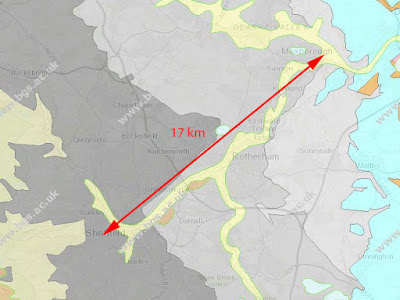To an archaeologist, Wincobank is best known for its well preserved Iron Age Hillfort, which is set upon the highest point of a prominent ridge of Silkstone Rock, with commanding views over the surrounding landscape.
As a geologist, however, it is the presence of a geological structure known as the Don Monocline that is of most interest to me - an asymmetrical anticline, whose steep limb dips south-east down to the Don Valley at an angle of up to 30 degrees.
In effect, it is like a ruck in the landscape, with the typical NNW-SSE strike of the Coal Measures strata being suddenly disrupted by a crustal movement that – for a stretch of 17 or more kilometres from Sheffield to Mexborough – changed the strike of the strata to SSW–NNE.
Having had a quick look at the former Wincobank Board School, I made my way up the adjacent path to explore Wincobank Common, which follows the Silkstone Rock ridge up to Jenkin Road - the next steepest street in Sheffield after Blake Street.
The views from the path that I followed are obscured in many places by woodland on either side and, having noted the sandstone setts used for steps and the path at the entrance to the common, I carried on until I reached a clearing with panoramic views to the north.
From here, I could look across Blackburn Brook to the escarpment of Silkstone Rock that I had recently encountered during my exploration of the Pennine Middle Coal Measures around Grange Park and Kimberworth in Rotherham.
Eventually arriving at a large open space, I went to have a quick look at the wonderful Star-Crossed Queen, an inscribed slate star map that I had discovered, along with a section of the Roman Rig, during a previous visit to Wincobank – when I walked from Meadowhall and back.
Arriving at Jenkin Road, there is one of my favourite sculptures in Sheffield. Entitled Posh Pillar and Her Daughters, it is made of cylinders of various granites that have two poems by Ebenezer Elliot, the Corn Law Rhymer inscribed into them – as well as another written by a 9 year old schoolgirl, which describes the WWII Sheffield Blitz.
Looking closely at the granites used for the Daughters, which are made from farm rollers, it is only the central memorial to Mary Ann Rawson, a Wincobank Hall resident and anti-slavery campaigner, that I recognise as being from the Corunubian Batholith in south-west England.
I am not very sure of the provenance of the granite used for the other rollers, or the large column that I have assumed to be salvaged from a now demolished historic building but, without access to a comprehensive collection of stone samples, it can be very difficult to identify these.
Set at the entrance to Wincobank Hill, it makes a very interesting start to an enjoyable walk across one of Sheffield’s most ancient landmarks, where I added further to my knowledge of the regional geology – and archaeology too.
 |
| An unknown granite |











No comments:
Post a Comment